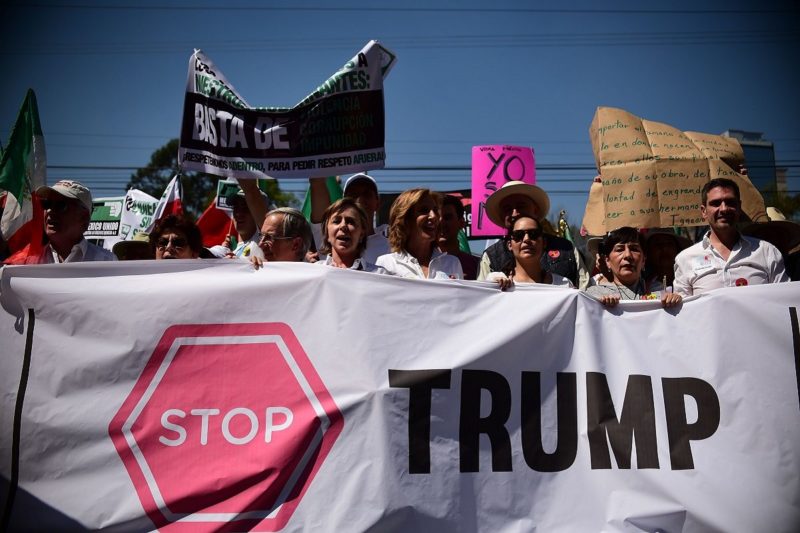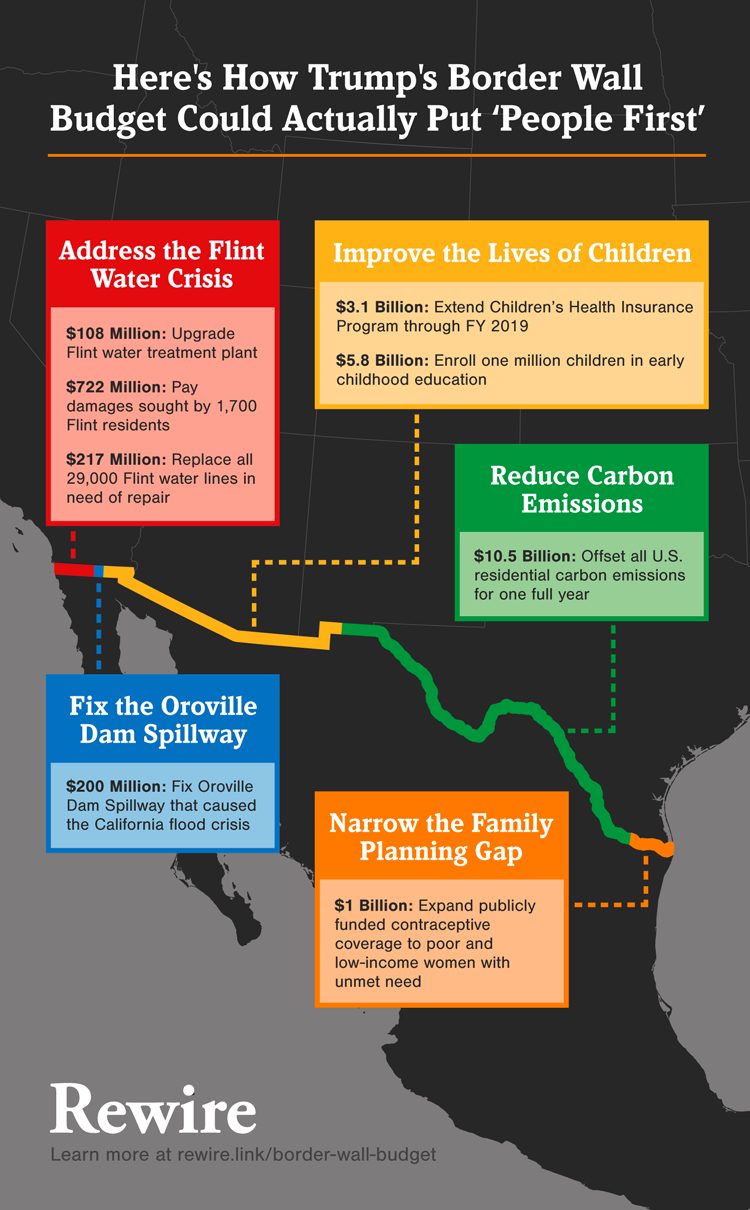Here’s How Trump’s Border Wall Budget Could Actually Put ‘People First’
Mr. Trump, don't build that wall. Invest in all of our people.

On the campaign trail and since taking office, President Donald Trump has persistently sought to gain and consolidate power by dividing people in the United States based on fear. Fear of immigrants who are “criminals“; fear of refugees who have not been vetted in an “extreme” enough manner for him; fear of Muslims who are allegedly plotting terrorist attacks; and fear of Black people, whom he blames for “crime” and “carnage.” His rhetoric isn’t demonization for its own sake, wrote Jamelle Bouie for Slate. Instead “it’s central to the president’s larger political vision, a white identity politics that looks with skepticism and hostility toward claims of racial injustice.”
Having sold enough voters on his rhetoric to win the election, Trump has now turned to implementing his vision. He imposed a Muslim ban, which has since been put on hold by the courts. He has dramatically reduced the number of refugees who will be accepted annually into the United States. And if Chicago’s violent crime rate doesn’t fall, he’s threatened to “send in the feds,” a euphemism for taking control over a city he has demonized and which, not incidentally, voted against him.
Citing baseless assertions that most immigrants coming from Mexico are “criminals,” Trump pledged to build a wall along the southern border. The wall, he claims, is part of his effort to keep Americans safe.
Trump is, whether he likes it or not, president of all the people of the United States, irrespective of race or creed. Spending an estimated $21.6 billion (not including the inevitable cost overruns) on fear-mongering will not keep any of us safe.
It is simply a diversion from real problems.
Millions more people in the United States are harmed or threatened by lack of access to clean water, failing infrastructure, poor quality education (which is linked to any number of positive health and social outcomes), and the rapidly rising costs of climate change, among other things.
There are any number of ways to spend nearly $22 billion to make things better in this country for all the people who live in it. We’ve decided to make a few suggestions to the president and to Congress about how this money might be better spent.

Address the Flint Water Crisis: $1.05 Billion
Human health depends on environmental health. There is perhaps no more fundamental sense of safety and peace of mind than the knowledge that the environment on which you and your family depend is clean and healthy.
But citizens of Flint, Michigan, have not had that sense of safety for more than three years now, since changes in their water supply meant to save money in support of tax cuts left the city with lead-contaminated water. Between April 2014 and October 2015, an estimated 99,000 residents of Flint were affected. Lead exposure is particularly harmful for pregnant women and young children. As the Centers for Disease Control and Prevention (CDC) has noted, lead kills developing brain cells with permanent consequences, including “lower IQ scores, poor school performance, inattention, impulsive behavior, aggression and hyperactivity. Studies increasingly link conduct disorder, delinquency, and criminal behaviors to lead toxicity.”
We therefore recommend that instead of a border wall, the president and Congress allocate funds to the following:
- $108 million to upgrade Flint’s water treatment plant: The most recent estimates suggest that the cost of upgrading the city’s water treatment plant, just one part of addressing the crisis in Flint, could cost $108 million. That includes, among other things, $37 million for the construction of two water storage tanks and “more than $34 million for upgrades in pump and transfer stations,” according to Michigan Live.
- $722 million to pay damages sought by 1,700 Flint residents: On January 30, more than 1,700 Flint residents filed a class action lawsuit seeking $722 million in damages against the Environmental Protection Agency (EPA) for “negligence … in its mishandling of the Flint Water Crisis.” Settling this suit would go at least part way toward providing relief to the people whose lives have been threatened and whose children are facing lifelong effects due to government negligence.
- $217 million to replace all 29,000 Flint water lines in need of repair: Let’s, finally, get the lead out.
Fix the Oroville Dam Spillway: $200 Million
This past week, nearly 200,000 people were evacuated from their homes due to a crisis caused by incessant rain and the subsequent breach of the spillway in California’s Oroville Dam. Lake Oroville is the largest reservoir in and the starting point for California’s State Water Project, which provides drinking water to 23 million of the state’s 39 million people and irrigates 750,000 acres of farms. Extensive repairs are needed to ensure the integrity of the Oroville Dam, a profoundly critical part of California’s water delivery system, and hence its economy and the health of the state’s people. State officials estimate repairs to the dam will cost at least $200 million.
Improve Lives of Children: $8.9 Billion
We could make any number of proposals for safeguarding the future of the children of this country, including dramatically expanding early childhood education; promoting environmental safety; ensuring all children have a rigorous; evidence-based education from kindergarten through college; nutrition; health care; and fulfilling a wide range of other needs. Given that we are “up against a wall” in terms of spending, we propose funds be diverted from the border wall to the following investments:
- $3.1 billion to extend the Children’s Health Insurance Program (CHIP) through FY 2019: CHIP provides low-cost health coverage to children and some pregnant women in families that earn too much money to qualify for Medicaid. Taken together, Medicaid and CHIP programs have significantly expanded health coverage among U.S. children, according to an analysis by the Kaiser Family Foundation.
From 1997, when CHIP was enacted, to 2012, the uninsured rate for children fell by half, from 14 percent to 7 percent. Medicaid and CHIP have helped reduce disparities in coverage that affect low-income children and children of color, providing better access to primary and preventive care.
- $5.8 billion to enroll one million children in early childhood education: Investing in a child’s early education stimulates future academic growth and provides financial and overall support to families. At an estimated cost of $5,832 per child, providing pre-kindergarten to one million children would cost nearly $5.8 billion. The impact, however, would be lasting and expansive.
Reduce Carbon Emissions: $10.5 Billion
The EPA documents man-made greenhouse gas emissions, known contributors to climate change. Climate change has dynamic effects on the environment and humans, many of which are costly, such as those caused by rising water levels. Imposing a tax on greenhouse gas emissions would allow governments to offset some of the damage. In 2014, 6 percent of U.S. greenhouse gas emissions came from the residential sector, according to the EPA. Based on the Congressional Budget Office’s recommended greenhouse gas emissions tax of $25 per ton, offsetting these residential emissions would cost $10.5 billion.
Narrow the Family Planning Gap: $1 Billion
The World Health Organization and the CDC both recognize the critical role played by family planning services and universal access to contraception in improving maternal, infant, and child health.
A study by the National Campaign to Prevent Teen and Unplanned Pregnancy estimates that just over 20 million women ages 13 to 44 are in need of publicly funded contraceptive services and lack “reasonable access” to a public clinic with the full range of methods.
In 2010, publicly funded family planning services helped women prevent 2.2 million unintended pregnancies, according to research by the Guttmacher Institute, avoiding 1.1 million unintended births and 760,000 abortions. And these investments yielded high returns: As Guttmacher’s Kinsey Hasstedt notes in the New York Times, publicly funded contraceptive services resulted in a net savings to the federal and state governments of $13.6 billion—$7 for every public dollar spent.
The federal government provides grants for family planning services through the Family Planning Program, commonly known as Title X of the Public Health Service Act. A report by the Congressional Research Service indicates that in 2015, Title X clinics served four million clients. Congressional appropriations for Title X programs remained static between 2015 and 2016, at $286 million. Investing an additional billion dollars to expand access to contraception to millions of people would dramatically improve public health and save billions of dollar.
We do not need a wall to keep us safe. We need compassion, understanding, investment in communities and in people who need health care, education, nutrition, housing, jobs, and a clean environment.
Mr. Trump, don’t build that wall. Invest in all of our people.
Infographic designed by Sarah Baker.
